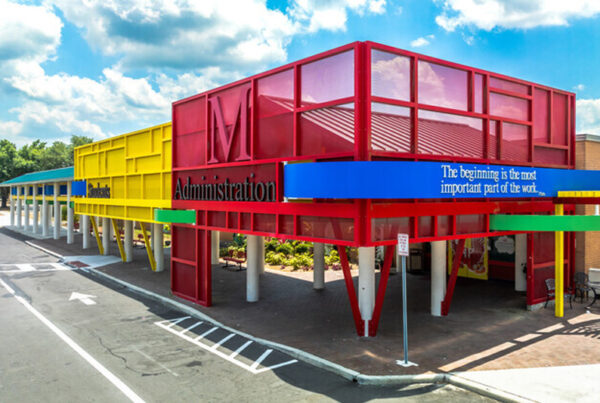
The Applied Research Center analyzed chronic absenteeism rates in 76 elementary, middle, and high schools that are implementing the Model of Instruction for Deeper Learning.
The Applied Research Center has previously studied how academic rigor in the classroom affects student outcomes, including chronic absenteeism. A peer-reviewed study found that schools that implemented the Model of Instruction for Deeper Learning and scored higher on the Rigor Appraisal Tool saw improved student attendance rates (Basileo et al., 2024).
Demographics
Schools: 76
Districts: 10
States: 7
Average rate of chronic absenteeism: 37%
Average rate of students from low socioeconomic backgrounds: 67%

The Applied Research Center used publicly available data for the following analysis of chronic absenteeism rates to determine whether schools implementing the Model of Instruction for Deeper Learning saw a reduction in chronic absenteeism.
Main Findings
- 5.6%: Median reduction of chronic absenteeism in schools implementing the Model of Instruction for Deeper Learning.
- 20%: Highest reduction of chronic absenteeism in a school implementing the Model of Instruction for Deeper Learning.
- 79% of schools implementing the Model of Instruction for Deeper Learning reduced chronic absenteeism.

Figure 1. Comparison of the average reduction in chronic absenteeism nationwide vs. the average reduction in schools implementing the Model of Instruction for Deeper Learning.
Schools implementing the Model of Instruction for Deeper Learning saw over twice as much reduction in chronic absenteeism compared to the national average. See Figure 1.
Thought leader Michael D. Toth and researcher Merewyn Lyons wrote about how traditional chronic absenteeism interventions often put little to no focus on improving students’ experience of classroom instruction. The Model of Instruction for Deeper Learning addresses the root causes of chronic absenteeism by transforming Tier 1 instruction to increase students’ intrinsic motivation and engagement and develop student agency.
Read more in their article about reducing chronic absenteeism.
Absenteeism Trends by Years of Implementation
The table below shows the average change in chronic absenteeism for the 2023-24 school year based on how many years a school has been receiving professional development to implement the Model of Instruction for Deeper Learning.
Schools in their first year of implementation saw an average reduction of 1.2%, while second-year schools experienced a 5.2% reduction. By the third year, schools averaged a 6% reduction. This trend indicates that schools with three years of professional development achieved an overall greater reduction in chronic absenteeism, with a nearly fivefold improvement.
| Year of Implementation | Number of Schools | Average Rate of Chronic Absenteeism Reduction |
| 1 | 15 | 1.2% |
| 2 | 7 | 5.2% |
| 3 | 54 | 6.0% |
Validating the Results: Statistical Significance of Findings
Longitudinal Teacher Survey Overview
The Applied Research Center conducted a longitudinal teacher survey to assess the implementation of the Model of Instruction for Deeper Learning. The survey was administered in two waves—fall 2023 and spring 2024—asking teachers about their use of the model.
Survey Participants:
- 422 teachers participated in both survey waves
- 11 districts
- 7 states
- 41 elementary, middle, and high schools
Implementation Strength and Chronic Absenteeism Reduction
A score was calculated based on teachers’ survey responses to determine each school’s level of implementation of the Model of Instruction for Deeper Learning.
When comparing implementation scores with chronic absenteeism data, results showed a clear trend: schools with higher implementation scores were more likely to see a reduction in chronic absenteeism. This relationship was statistically significant (p = .033).
- A one-unit increase in the implementation score was linked to a 3.5 percentage point reduction in chronic absenteeism.
- These findings suggest that stronger implementation of the Model of Instruction for Deeper Learning is associated with greater reductions in absenteeism.
Impact of Implementation Over Time
The Applied Research Center also analyzed whether the number of years a school had been receiving professional development to implement the Model of Instruction for Deeper Learning influenced absenteeism rates.
- Each additional year of implementation was associated with a 3.3 percentage point reduction in chronic absenteeism. This finding was statistically significant (p = .003).
- Years of implementation was the strongest predictor of absenteeism reduction with the largest standardized effect (Beta = -.572).
- The results suggest a consistent, year-over-year reduction of absenteeism, indicating that the impact of the Model of Instruction for Deeper Learning increases over time.
Key Takeaways
- Stronger implementation of the Model of Instruction for Deeper Learning and more years of professional development led to significant reductions in chronic absenteeism.
- Both implementation level and years of experience with the model were statistically significant predictors of absenteeism reduction.
- Factors such as the percentage of English learners and students from low socioeconomic backgrounds were also analyzed and did not affect these findings, meaning the impact was consistent across different school populations.
About the Model of Instruction for Deeper Learning
There has always been deeper learning for some students – but not for ALL students in every classroom, every day. Now it is possible with the research-based Model of Instruction for Deeper Learning™, which provides every teacher and all students with the professional learning, support, and resources to achieve deeper, more rigorous learning of the curriculum.
The Model of Instruction for Deeper Learning places students at the center of their learning, shifting from traditional teacher-directed methods to student-led team learning. In this approach, students collaborate in structured, interdependent teams, guided by clear roles and responsibilities. Unlike traditional grouping, this approach ensures equal participation and accountability – fostering deeper understanding, critical thinking, and collaboration.
References
Basileo, L. D., Lyons, M. E., & Toth, M. D. (2024). Leading indicators of academic achievement: Investigating the predictive validity of an observation instrument in a large district. Sage Open, 14(2). https://doi.org/10.1177/21582440241261119
FutureEd. (2025, February 27). Tracking state trends in absenteeism. https://www.future-ed.org/tracking-state-trends-in-chronic-absenteeism/
Subscribe for curated education insights delivered every two weeks.
About Instructional Empowerment
Our mission is to end generational poverty and eliminate achievement gaps through redesigned rigorous Tier 1 Instruction that ensures deeper learning for ALL students.




